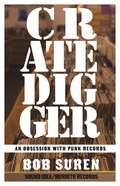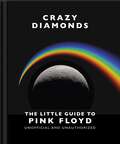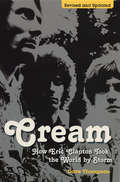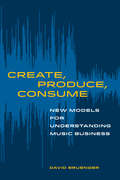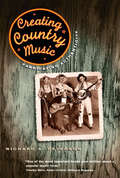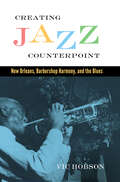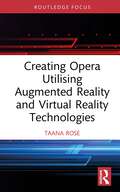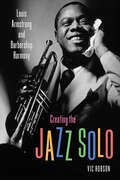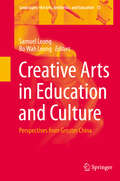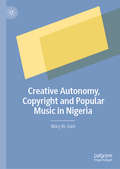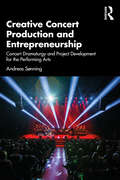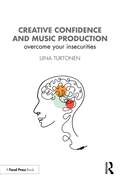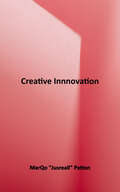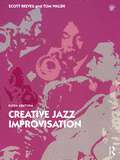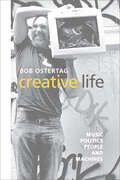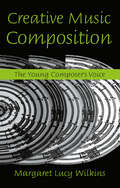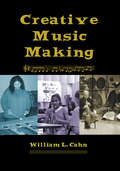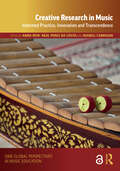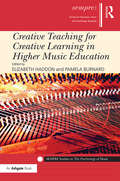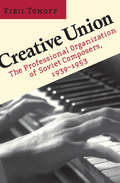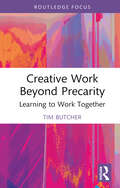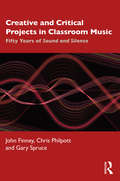- Table View
- List View
Crate Digger
by Bob SurenA small town Florida teenager discovers punk rock through a loaned mix tape and punk music and culture slowly takes over all aspects of his life. His new passion causes him to form a band, track down out-of-print records that he loves and begin to reissue them, open a record store, begin a record distribution operation as a public service, mentor a host of young musicians, and befriend all manner of punk luminaries along the way. Slowly, his life’s pursuit pushes him to the point of personal ruination and ultimately redemption.
Crazy Diamonds: The Little Guide to Pink Floyd
by Orange Hippo!Pink Floyd are firmly in the pantheon of all-time great rock bands, with their name as well known and well respected now as it was 50 years ago. And with such legendary albums as The Dark Side of the Moon and The Wall still adored today, you can bet Pink Floyd will still be loved 50 years from now.This little guide is the ultimate companion to the band's celebrated music, packed full of trivia, facts and quotes from the band themselves and their famous fans.
Crazy Diamonds: The Little Guide to Pink Floyd
by Orange Hippo!Pink Floyd are firmly in the pantheon of all-time great rock bands, with their name as well known and well respected now as it was 50 years ago. And with such legendary albums as The Dark Side of the Moon and The Wall still adored today, you can bet Pink Floyd will still be loved 50 years from now.This little guide is the ultimate companion to the band's celebrated music, packed full of trivia, facts and quotes from the band themselves and their famous fans.
Cream: How Eric Clapton Took the World by Storm
by Dave ThompsonDave Thompson, author of Virgin's acclaimed Red Hot Chili Peppers biography, takes a new and very detailed look at the creation of one of the world's most influential bands. After all the streets of London had been covered in 'Clapton Is God' tributes, the three top rock instrumentalists of their time, all stars in their own right, came together to form Cream. Cream went on to become the first band to break openthe lucrative US market by dint of their live shows alone. Updated to include details of their recent tour, this definitive account goes on the road with them then and now, day by relentlessly hedonistic day.
Create, Produce, Consume: New Models for Understanding Music Business
by David BruengerCreate, Produce, Consume explores the cycle of musical experience for musicians, professionals, and budding entrepreneurs looking to break into the music industry. Building on the concepts of his previous book, Making Money, Making Music, David Bruenger provides readers with a basic framework for understanding the relationships between the artist and audience and the producer consumer by examining the methods underlying creation-production-reception and creation-consumption-compensation. Each chapter offers a different perspective on the processes and structures that lead listeners to discover, experience, and interact with music and musical artists. Through case studies ranging from Taylor Swift’s refusal to allow her music to be streamed on Spotify to the rise of artists supported through sites like Patreon, Bruenger offers highly relevant real-world examples of industry practices that shape our encounters with music. Create, Produce, Consume is a critical tool for giving readers the agile knowledge necessary to adapt to a rapidly changing music industry. Graphs, tables, lists for additional reading, and questions for further discussion illustrate key concepts. Online resources for instructors and students will include sample syllabi, lists for expanded reading, and more.
Creating Country Music: Fabricating Authenticity
by Richard A. PetersonIn Creating Country Music, Richard Peterson traces the development of country music and its institutionalization from Fiddlin' John Carson's pioneering recordings in Atlanta in 1923 to the posthumous success of Hank Williams. Peterson captures the free-wheeling entrepreneurial spirit of the era, detailing the activities of the key promoters who sculpted the emerging country music scene. More than just a history of the music and its performers, this book is the first to explore what it means to be authentic within popular culture. "[Peterson] restores to the music a sense of fun and diversity and possibility that more naive fans (and performers) miss. Like Buck Owens, Peterson knows there is no greater adventure or challenge than to 'act naturally. '"—Ken Emerson, Los Angeles Times Book Review "A triumphal history and theory of the country music industry between 1920 and 1953. "—Robert Crowley, International Journal of Comparative Sociology "One of the most important books ever written about a popular music form. "—Timothy White, Billboard Magazine
Creating Country Music: Fabricating Authenticity
by Richard A. PetersonIn Creating Country Music, Richard Peterson traces the development of country music and its institutionalization from Fiddlin' John Carson's pioneering recordings in Atlanta in 1923 to the posthumous success of Hank Williams. Peterson captures the free-wheeling entrepreneurial spirit of the era, detailing the activities of the key promoters who sculpted the emerging country music scene. More than just a history of the music and its performers, this book is the first to explore what it means to be authentic within popular culture. "[Peterson] restores to the music a sense of fun and diversity and possibility that more naive fans (and performers) miss. Like Buck Owens, Peterson knows there is no greater adventure or challenge than to 'act naturally.'"—Ken Emerson, Los Angeles Times Book Review "A triumphal history and theory of the country music industry between 1920 and 1953."—Robert Crowley, International Journal of Comparative Sociology "One of the most important books ever written about a popular music form."—Timothy White, Billboard Magazine
Creating Jazz Counterpoint: New Orleans, Barbershop Harmony, and the Blues (American Made Music Series)
by Vic HobsonThe book Jazzmen (1939) claimed New Orleans as the birthplace of jazz and introduced the legend of Buddy Bolden as the "First Man of Jazz." Much of the information that the book relied on came from a highly controversial source: Bunk Johnson. He claimed to have played with Bolden and that together they had pioneered jazz. Johnson made many recordings talking about and playing the music of the Bolden era. These recordings have been treated with skepticism because of doubts about Johnson's credibility. Using oral histories, the Jazzmen interview notes, and unpublished archive material, this book confirms that Bunk Johnson did play with Bolden. This confirmation, in turn, has profound implications for Johnson's recorded legacy in describing the music of the early years of New Orleans jazz. New Orleans jazz was different from ragtime in a number of ways. It was a music that was collectively improvised, and it carried a new tonality--the tonality of the blues. How early jazz musicians improvised together and how the blues became a part of jazz has until now been a mystery. Part of the reason New Orleans jazz developed as it did is that all the prominent jazz pioneers, including Buddy Bolden, Bunk Johnson, Louis Armstrong, Sidney Bechet, Johnny Dodds, and Kid Ory, sang in barbershop (or barroom) quartets. This book describes in both historical and musical terms how the practices of quartet singing were converted to the instruments of a jazz band, and how this, in turn, produced collectively improvised, blues-inflected jazz, that unique sound of New Orleans.
Creating Opera Utilising Augmented Reality and Virtual Reality Technologies
by Taana RoseThis book investigates the use of extended reality (XR) technologies to innovate the opera experience.Through the creation and comparison of three versions of the original opera Artemis, the research explores how virtual and augmented reality platforms can transform traditional composition and staging practices. The project resulted in three distinct iterations: a virtual reality opera built in Unity3D for the Oculus Quest, a 360° YouTube VR opera, and an augmented reality live performance. Each version utilised self-experiential prototyping to craft immersive environments and novel compositional approaches. Key features of the book include a detailed analysis of prototyping methods for XR opera development, with an emphasis on combining autoethnography, world-building, and user-centric design. By leveraging tools like Unity3D and 3D spatial sound technology, the research demonstrates how XR environments can enhance the sensory and emotional engagement of both creators and audiences. Readers will gain practical insights into designing XR operas, from managing technical constraints to creating immersive soundscapes and environments that align with operatic narratives.This book will appeal to an academic audience in fields such as music technology, interaction design, composition, and virtual reality architecture. It provides valuable contributions for undergraduate and postgraduate students, creative practice researchers, and professionals seeking to explore the intersections of technology, performance, and composition. With its multidisciplinary approach, the book offers a roadmap for applying innovative techniques to the creation of XR operatic works and beyond.
Creating the Jazz Solo: Louis Armstrong and Barbershop Harmony (American Made Music Series)
by Vic HobsonThroughout his life, Louis Armstrong tried to explain how singing with a barbershop quartet on the streets of New Orleans was foundational to his musicianship. Until now, there has been no in-depth inquiry into what he meant when he said, “I figure singing and playing is the same,” or, “Singing was more into my blood than the trumpet.” Creating the Jazz Solo: Louis Armstrong and Barbershop Harmony shows that Armstrong understood exactly the relationship between what he sang and what he played, and that he meant these comments to be taken literally: he was singing through his horn.To describe the relationship between what Armstrong sang and played, author Vic Hobson discusses elements of music theory with a style accessible even to readers with little or no musical background. Jazz is a music that is often performed by people with limited formal musical education. Armstrong did not analyze what he played in theoretical terms. Instead, he thought about it in terms of the voices in a barbershop quartet.Understanding how Armstrong, and other pioneer jazz musicians of his generation, learned to play jazz and how he used his background of singing in a quartet to develop the jazz solo has fundamental implications for the teaching of jazz history and performance today. This assertive book provides an approachable foundation for current musicians to unlock the magic and understand jazz the Louis Armstrong way.
Creative Arts in Education and Culture: Perspectives from Greater China (Landscapes: the Arts, Aesthetics, and Education #13)
by Samuel Leong Bo Wah LeungThis book offers insights into the exciting dynamics permeating creative arts education in the Greater China region, focusing on the challenges of forging a future that would not reject, but be enriched by its Confucian and colonial past. Today's 'Greater China' - comprising China, Hong Kong, Macau and Taiwan - has grown into a vibrant and rapidly transforming region characterized by rich historical legacies, enormous dynamism and exciting cultural metamorphosis. Concomitant with the economic rise of China and widespread calls for more 'creative' and 'liberal' education, the educational and cultural sectors in the region have witnessed significant reforms in recent years. Other factors that will influence the future of arts education are the emergence of a 'new' awareness of Chinese cultural values and the uniqueness of being Chinese.
Creative Autonomy, Copyright and Popular Music in Nigeria
by Mary W. GaniThis book provides an in-depth analysis of the unique structure of the Nigerian popular music industry. It explores the dissonance between copyright’s thematic support for creative autonomy and the practical ways in which the law allows singer-songwriters’ (performing authors') creative autonomy to be subverted in their contractual relationships with record labels. The book establishes the concept of creative autonomy for performing authors as a key criterion for sustainable economic development, and makes innovative legal and policy recommendations to help stakeholders preserve it.
Creative Concert Production and Entrepreneurship: Concert Dramaturgy and Project Development for the Performing Arts
by Andreas SonningCreative Concert Production and Entrepreneurship: Concert Dramaturgy and Project Development for the Performing Arts offers a conceptual and applied introduction to the musical and dramaturgical challenges involved in developing and producing concerts. Drawing from over three decades of real-world experience and a range of international case studies, the author explores new models for cooperation between artists, cultural institutions, governments, and businesses, arguing for the importance of rooting the concert production process in artistic and ethical values. The book presents essential knowledge and techniques to meet the demand for music and stage performances across genres, arenas, formats, and distribution channels. Relevant to a wide range of students and professionals in music and the performing arts, Creative Concert Production and Entrepreneurship marries theory with practice, providing a framework for readers to develop the creative entrepreneurial practices essential for success in today’s music industry.
Creative Confidence and Music Production: Overcome Your Insecurities
by Liina TurtonenCreative Confidence and Music Production: Overcome Your Insecurities is a practical guide for music producers to tackle self-doubt and navigate the relationship between confidence and creativity, by offering tools to overcome the most common creative blocks.The book begins by discussing the interrelationships between confidence, creativity, and working with technology. This is followed by chapters featuring expert tips and practical exercises to help readers overcome challenges such as struggling with confidence in their production process, and navigating the music industry as an artist. Also included are sections that focus on creative music production workflows, providing practical tips on how to find creative direction and how to work through creative blocks, before finishing with real stories from a range of diverse music professionals about their own workflows, what inspires them, and how they overcome doubt, uncertainty, and lack of inspiration.Although mainly aimed at music producers, Creative Confidence and Music Production has plenty of insights for anyone in the music industry, and can help beginners, music production students, and seasoned professionals alike, to face their fears and foster confidence in their practice.
Creative Innovation: A Creative's Guide to Applied Creative Efficacy
by MarQo PattonThe current landscape of creative exploitation in the entertainment industry is complex and lacks foundational, agreed-upon development pedagogies for individual success. In a digitally-integrated society, it is our thinking that everyone is a student; and today's students find value in interactive, effective, and affordable strategies that are easily accessible. Through the expertise and content synthesis of Jusreall Music Group Global, LLC (JMGG), industry creatives can develop and sharpen their skills in general music production and artist business, with topics like poetic devices; vocal placement; health, lifestyle and coaching; effective sound checks; sound manipulation; branding; copyrights; registration; acting and self-taping; and more. With 50 synthesized mini-lessons and 13 explorations (applied activities), from scholar-practitioner MarQo "Jusreall" EdD--modern creative vocalists, recording artists, musicians, creative institutions, music companies and those who work with creatives have access to a wealth of knowledge that will benefit any 21st-century professional in the music business.
Creative Jazz Improvisation
by Scott Reeves Tom WalshThe leading textbook in jazz improvisation, Creative Jazz Improvisation, Fifth Edition represents a compendium of knowledge and practice resources for the university classroom, suitable for all musicians looking to develop and sharpen their soloing skills. Logically organized and guided by a philosophy that encourages creativity, this book presents practical advice beyond the theoretical, featuring exercises in twelve keys, ear training and keyboard drills, a comprehensive catalog of relevant songs to learn, and a wide range of solo transcriptions, each transposed for C, Bb, Eb, and bass clef instruments. Chapters highlight discussions of jazz theory - covering topics such as major scale modes, forms, chord substitutions, melodic minor modes, diminished and whole-tone modes, pentatonic scales, intervallic improvisation, free improvisation, and more - while featuring updated content throughout on the nuts and bolts of learning to improvise. New to the Fifth Edition: Co-author Tom Walsh Additional solo transcriptions featuring the work of female and Latino jazz artists A new chapter, “Odd Meters” A robust companion website featuring additional exercises, ear training, play-along tracks, tunes, call and response tracks, keyboard voicings, and transcriptions, alongside Spotify and YouTube links to many of the featured solos Rooted in an understanding that there is no one right way to learn jazz, Creative Jazz Improvisation, Fifth Edition explores the means and methods for developing one’s jazz vocabulary and improvisational techniques.
Creative Life: Music, Politics, People, and Machines
by Bob OstertagIn this eloquent and passionate volume, Bob Ostertag explores the common ground and points of friction among music, creativity, politics, culture, and technology. In terrain ranging from the guerrilla underground in El Salvador's civil war to the drag queen underground in San Francisco and New York, these essays combine journalism and autobiography to explore fundamental questions of what art is and what role it can occupy in a violent and fragmented world, a world in which daily events compromise the universality toward which art strives. Drawing on his intimate engagement with political conflict in Latin America and the Balkans, Ostertag identifies an art of "insurgent politics" that struggles to expand the parameters of the physical and social world. He also discusses his innovative collaborations with major modern performers, filmmakers, and artists around the world. Part memoir, part journalism, and part aesthetic manifesto, Creative Life is a dazzling set of writings from a musical artist who has worked on the cutting edge of new music for thirty years.
Creative Music Composition: The Young Composer's Voice
by Margaret Lucy WilkinsCreative Music Composition is designed to be an introductory textbook for music students. "Creative composition"-composing in your own style, rather than in the style of a composer of the past-is embraced by music educators not only for composition students, but for beginning performers and music educators, and is often offered to all music students and non-music majors who wish to enhance their musical creativity. With 25 years of experience teaching fledgling composers, the author tackles the key ingredients that make for successful composition, including: stimulus to the musical imagination; discussion of a variety of current musical languages; analysis of many examples from contemporary scores; technical exercises; suggestions as to how to start a composition; structures; and examinations of works from particular genres. Wilkins covers several musical languages, from folk and popular to serialism; analyses various rhythmic forms; suggests approaches for composing for a variety of instruments, from traditional to electronic ones, as well as for the human voice; addresses the nuts and bolts of score preparation; and offers career advice. For all composition students-and for music students in general-Creative Music Composition offers a clear and concise introduction that will enable them to reach their personal goals.
Creative Music Making
by William L CahnMost musicians focus on learning technique (learning how to play an instrument), rather than on developing an individual, unique voice. Creative Music Making focuses on the creative development of musicians from all levels of experience and in all styles of music. Based on the author's experience leading workshops for performers around the world, the easy-to-follow exercises in this text will enable any musician--from beginner to professional--to improve creativity and self-expression. Creative Music Making will open the ears of all musicians, vocalists or instrumentalists, in classical, popular, or jazz styles, to a world of new possibilities.
Creative Research in Music: Informed Practice, Innovation and Transcendence (ISME Series in Music Education)
by Anna Reid Neal Peres Da Costa Jeanell CarriganCreative Research in Music explores what it means to be an artistic researcher in music in the twenty-first century. The book delineates the myriad processes that underpin successful artistic research in music, providing best practice exemplars ranging from Western classical art to local indigenous traditions, and from small to large-scale, multi-media and cross-cultural work formats. Drawing on the richness of creative research work at key institutions in South-East Asia and Australian, this book examines the social, political, historical and cultural driving forces that spur and inspire excellence in creative research to extend and to cross boundaries, to sustain our music industry, to advocate for the importance of music in our world, and to make it clear that music matters. In the chapters, our authors present the ideas of informed practice, innovation and transcendence from diverse international perspectives. Each of these three themes has an introductory section where the theme is explored and the chapters in that section introduced. Taken as a whole, the book discusses how the themes in combination, with reference to the authorial group, are able to transform music pedagogy and performance for our global and complex world.
Creative Research in Music: Informed Practice, Innovation and Transcendence (ISME Series in Music Education)
by Anna Reid Jeanell Carrigan Costa, Neal Peres DaCreative Research in Music explores what it means to be an artistic researcher in music in the twenty-first century. The book delineates the myriad processes that underpin successful artistic research in music, providing best practice exemplars ranging from Western classical art to local indigenous traditions, and from small to large-scale, multi-media and cross-cultural work formats. Drawing on the richness of creative research work at key institutions in South-East Asia and Australian, this book examines the social, political, historical and cultural driving forces that spur and inspire excellence in creative research to extend and to cross boundaries, to sustain our music industry, to advocate for the importance of music in our world, and to make it clear that music matters.In the chapters, our authors present the ideas of informed practice, innovation and transcendence from diverse international perspectives. Each of these three themes has an introductory section where the theme is explored and the chapters in that section introduced. Taken as a whole, the book discusses how the themes in combination, with reference to the authorial group, are able to transform music pedagogy and performance for our global and complex world.Chapter 9 of this book is freely available as a downloadable Open Access PDF at http://www.taylorfrancis.com under a Creative Commons Attribution-Non Commercial-No Derivatives (CC-BY-NC-ND) 4.0 license.
Creative Teaching for Creative Learning in Higher Music Education (SEMPRE Studies in The Psychology of Music)
by Pamela Burnard Elizabeth HaddonThis edited volume explores how selected researchers, students and academics name and frame creative teaching and learning as constructed through the rationalities, practices, relationships, events, objects and systems that are brought to educational sites and developed by learning communities. The concept of creative learning questions the starting-points and opens up the outcomes of curriculum, and this frames creative teaching not only as a process of learning but as an agent of change. Within the book, the various creativities that are valued by different stakeholders teaching and studying in the higher music sector are delineated, and processes and understandings of creative teaching are articulated, both generally in higher music education and specifically through their application within the design of individual modules. This focus makes the text relevant to scholars, researchers and practitioners across many fields of music, including those working in musicology, composition, performance, music education, and music psychology. The book contributes new perspectives on our understanding of the role of creative teaching and learning and processes in creative teaching across the domain of music learning in higher music education sectors.
Creative Union: The Professional Organization of Soviet Composers, 1939–1953
by Kiril TomoffWhy did the Stalin era, a period characterized by bureaucratic control and the reign of Socialist Realism in the arts, witness such an extraordinary upsurge of musical creativity and the prominence of musicians in the cultural elite? This is one of the questions that Kiril Tomoff seeks to answer in Creative Union, the first book about any of the professional unions that dominated Soviet cultural life at the time. Drawing on hitherto untapped archives, he shows how the Union of Soviet Composers established control over the music profession and negotiated the relationship between composers and the Communist Party leadership. Central to Tomoff's argument is the institutional authority and prestige that the musical profession accrued and deployed within Soviet society, enabling musicians to withstand the postwar disciplinary campaigns that were so crippling in other artistic and literary spheres.Most accounts of Soviet musical life focus on famous individuals or the campaign against Shostakovich's Lady Macbeth and Zhdanov's postwar attack on musical formalism. Tomoff's approach, while not downplaying these notorious events, shows that the Union was able to develop and direct a musical profession that enjoyed enormous social prestige. The Union's leadership was able to use its expertise to determine the criteria of musical value with a degree of independence. Tomoff's book reveals the complex and mutable interaction of creative intelligentsia and political elite in a period hitherto characterized as one of totalitarian control.
Creative Work Beyond Precarity: Learning to Work Together (Routledge Focus on the Global Creative Economy)
by Tim ButcherThis book offers an original critical evaluation of how freelance careers can be established and sustained in the increasingly uncertain global creative economy. Developing from the author’s theoretical and empirical research at the nexus of precarious work and entrepreneurial learning, it provides an in-depth understanding of why and how creatives can learn to become entrepreneurial and how this relates to creative entrepreneurship. This book traces how arts work became creative labour and explores the contemporary organisation of artistic and creative practices to understand practical alternatives to the individualised careers we currently feel responsible for maintaining. Inspired particularly by the work of Raymond Williams, creative work is reconceptualised as practice-based collaborative learning encounters through which we might put shared feelings of precarity to work towards the production and practice of alternative possibilities. Accessible and concise, breaking down complex concepts through practical examples and linking the creative process to entrepreneurial learning, this book will be of interest to students, educators and researchers studying and working in the creative economy.
Creative and Critical Projects in Classroom Music: Fifty Years of Sound and Silence
by Gary Spruce John Finney Chris PhilpottCreative and Critical Projects in Classroom Music is both a celebration and extension of John Paynter and Peter Aston’s groundbreaking work on creative classroom music, Sound and Silence, first published in 1970. Building on the central themes of the original work – the child as artist, the role of musical imagination and creativity, and the process of making music – the authors and contributors provide a contemporary response to the spirit and style of Sound and Silence. They offer reflections on the ideas and convictions underpinning Paynter and Aston’s work in light of scholarship developed during the intervening years. This critical work is accompanied by 16 creative classroom projects designed and enacted by contemporary practitioners, raising questions about the nature and function of music in education and society. In summary, this book aims to: Celebrate seminal work on musical creativity in the classroom. Promote the integration of practical, critical and analytical writing and thinking around this key theme for music education. Contribute to initiating the next 50 years of thought in relation to music creativity in the classroom. Offering a unique combination of critical scholarship and practical application, and published on the occasion of the 50th anniversary of Sound and Silence, themes from Paynter and Aston’s work are here given fresh context that aims to inspire a new generation of innovative classroom practice and to challenge current ways of thinking about the music classroom.
